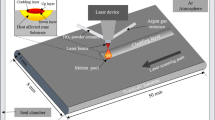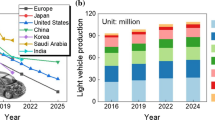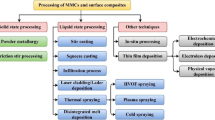Abstract
This study investigates the effects of incorporating Ti3AlC2 MAX phase into Al7075-T6 alloy by friction stir processing as well as adding Al2O3 nanoparticles to obtain a surface hybrid nanocomposite. These composites were successfully prepared by friction stir processing with a rotational speed of 1000 rpm and a travel speed of 28 mm/min after 3 passes. Optical, atomic force and scanning electron microscopy as well as microhardness, tensile, and wear tests were utilized to characterize the fabricated surface hybrid nanocomposites. Results showed that the maximum tensile strength and hardness value were achieved for Al-100% Al2O3 composite due to more grain refinement and effective dispersion of nanoparticles. Due to its laminar structure, Ti3AlC2 MAX phase enhanced better tribological characterization, whereas Al2O3 nanoparticles cause better mechanical properties. Scanning electron microscopy tests revealed that the wear mechanism changes from adhesive for Al7075 alloy to adhesive-abrasive for the nanocomposite specimens.
















Similar content being viewed by others
References
Totten GE, MacKenzie DS (2003)Handbook of aluminum: vol. 1: physical metallurgy and processes. CRC press
Heinz A, Haszler A, Keidel C, Moldenhauer S, Benedictus R, Miller W (2000) Recent development in aluminium alloys for aerospace applications. Materials Science and Engineering: A280:102–107
Williams JC, Starke EA Jr (2003) Progress in structural materials for aerospace systems. Acta Materialia51:5775–5799
Miracle D (2005) Metal matrix composites–from science to technological significance. Composites science and technology65:2526–2540
Guo J, Gougeon P, Chen X-G(2012) Study on laser welding of AA1100-16 vol.% B4C metal–matrix composites. Composites Part B: Engineering43:2400–2408
Ahmadifard S, Kazemi S, Heidarpour A (2018) Production and characterization of A5083–Al2O3–TiO2 hybrid surface nanocomposite by friction stir processing. Proceedings of the Institution of Mechanical Engineers, Part L: Journal of Materials: Design and Applications232:287–293
Hosseini S, Ranjbar K, Dehmolaei R, Amirani A (2015) Fabrication of Al5083 surface composites reinforced by CNTs and cerium oxide nano particles via friction stir processing. Journal of Alloys and Compounds622:725–733
Srinivasu R, Rao AS, Reddy GM, Rao KS (2015) Friction stir surfacing of cast A356 aluminium–silicon alloy with boron carbide and molybdenum disulphide powders. Defence Technology11:140–146
Mahmoud ER, Takahashi M, Shibayanagi T, Ikeuchi K (2010) Wear characteristics of surface-hybrid-MMCs layer fabricated on aluminum plate by friction stir processing. Wear268:1111–1121
Asl AM, Khandani S (2013) Role of hybrid ratio in microstructural, mechanical and sliding wear properties of the Al5083/Graphite/Al2O3p a surface hybrid nanocomposite fabricated via friction stir processing method. Materials Science and Engineering: A559:549–557
Manochehrian A, Heidarpour A, Mazaheri Y, Ghasemi S (2019) On the surface reinforcing of A356 aluminum alloy by nanolayered Ti3AlC2 MAX phase via friction stir processing. Surface and Coatings Technology377:124884
Janbozorgi M, Shamanian M, Sadeghian M, Sepehrinia P (2017) Improving tribological behavior of friction stir processed A413/SiCp surface composite using MoS2 lubricant particles. Transactions of Nonferrous Metals Society of China27:298–304
Dubourg, L., Hlawka, F., and Cornet, A. (2002) Surface and coatings technology 151-152. 329-332
Choo S-H, Lee S, Kwon S-J(1999) Effect of flux addition on the microstructure and hardness of TiC-reinforced ferrous surface composite layers fabricated by high-energy electron beam irradiation. Metallurgical and Materials Transactions A30:3131–3141
Znamirowski Z, Pawlowski L, Cichy T, Czarczynski W (2004) Low macroscopic field electron emission from surface of plasma sprayed and laser engraved TiO2, Al2O3+ 13TiO2 and Al2O3+ 40TiO2 coatings. Surface and coatings Technology187:37–46
Mishra RS, Ma Z (2005) Friction stir welding and processing. Materials science and engineering: R: reports50:1–78
Arora H, Singh H, Dhindaw B (2012) Composite fabrication using friction stir processing—a review. The International Journal of Advanced Manufacturing Technology61:1043–1055
Gibson BT, Lammlein D, Prater T, Longhurst W, Cox C, Ballun M, Dharmaraj K, Cook G, Strauss A (2014) Friction stir welding: process, automation, and control. Journal of Manufacturing Processes16:56–73
Humphreys FJ, Prangnell PB, Priestner R (2001)Fine-grained alloys by thermomechanical processing. Current Opinion in Solid State and Materials Science5:15–21
Bai Y, He X, Wang R, Wang S, Kong F (2014) Effect of transition metal (M) and M–C slabs on equilibrium properties of Al-containing MAX carbides: an ab initio study. Computational materials science91:28–37
McNelley T, Swaminathan S, Su J (2008) Recrystallization mechanisms during friction stir welding/processing of aluminum alloys. Scripta Materialia58:349–354
Shahi A, Sohi MH, Ahmadkhaniha D, Ghambari M (2014) In situ formation of Al–Al 3 Ni composites on commercially pure aluminium by friction stir processing. The International Journal of Advanced Manufacturing Technology75:1331–1337
Guru P, Khan F, Panigrahi S, Ram GJ (2015) Enhancing strength, ductility and machinability of a Al–Si cast alloy by friction stir processing. Journal of Manufacturing Processes18:67–74
Kheirkhah S, Imani M, Aliramezani R, Zamani M, Kheilnejad A (2019) Microstructure, mechanical properties and corrosion resistance of Al6061/BN surface composite prepared by friction stir processing. Surface Topography: Metrology and Properties7:035002
Rao A, Deshmukh V, Prabhu N, Kashyap B (2016) Enhancing the machinability of hypereutectic Al-30Si alloy by friction stir processing. Journal of Manufacturing Processes23:130–134
Da Silva J, Costa J, Loureiro A, Ferreira J (2013) Fatigue behaviour of AA6082-T6 MIG welded butt joints improved by friction stir processing. Materials & Design51:315–322
Sharma SR, Ma Z, Mishra RS (2004) Effect of friction stir processing on fatigue behavior of A356 alloy. Scripta Materialia51:237–241
Mazaheri Y, Karimzadeh F, Enayati M (2014) Tribological behavior of A356/Al 2 O 3 surface nanocomposite prepared by friction stir processing. Metallurgical and Materials Transactions A45:2250–2259
Hussain G, Hashemi R, Hashemi H, Al-Ghamdi KA (2016) An experimental study on multi-pass friction stir processing of Al/TiN composite: some microstructural, mechanical, and wear characteristics. The International Journal of Advanced Manufacturing Technology84:533–546
Poon B, Ponson L, Zhao J, Ravichandran G (2011) Damage accumulation and hysteretic behavior of MAX phase materials. Journal of the Mechanics and Physics of Solids59:2238–2257
Heidarpour A, Shahin N, Kazemi S (2017) A novel approach to in situ synthesis of WC-Al2O3 composite by high energy reactive milling. International Journal of Refractory Metals and Hard Materials64:1–6
Zhou A, Wang C-A, Hunag Y (2003) Synthesis and mechanical properties of Ti 3 AlC 2 by spark plasma sintering. Journal of Materials Science38:3111–3115
Tzenov NV, Barsoum MW (2000) Synthesis and characterization of Ti3AlC2. Journal of the American Ceramic Society83:825–832
Yeh C, Kuo C, Chu Y (2010) Formation of Ti3AlC2/Al2O3 and Ti2AlC/Al2O3 composites by combustion synthesis in Ti–Al–C–TiO2 systems. Journal of Alloys and Compounds494:132–136
Yeh C, Shen Y (2009) Effects of using Al4C3 as a reactant on formation of Ti3AlC2 by combustion synthesis in SHS mode. Journal of Alloys and Compounds473:408–413
Shahin N, Kazemi S, Heidarpour A (2016) Mechanochemical synthesis mechanism of Ti3AlC2 MAX phase from elemental powders of Ti, Al and C. Advanced Powder Technology27:1775–1780
Jin S, Liang B, Li J-F, Ren L (2007) Effect of Al addition on phase purity of Ti3Si (Al) C2 synthesized by mechanical alloying. Journal of Materials Processing Technology182:445–449
Liang B, Han X, Zou Q, Zhao Y, Wang M (2009)TiC/Ti3SiC2 composite prepared by mechanical alloying. International Journal of Refractory Metals and Hard Materials27:664–666
Khodabakhshi F, Simchi A, Kokabi A, Nosko M, Simanĉik F, Švec P (2014) Microstructure and texture development during friction stir processing of Al–Mg alloy sheets with TiO2 nanoparticles. Materials Science and Engineering: A605:108–118
Du Z, Tan MJ, Guo JF, Bi G, Wei J (2016) Fabrication of a new Al-Al2O3-CNTs composite using friction stir processing (FSP). Materials Science and Engineering: A667:125–131
Su J-Q, Nelson T, Sterling C (2006) Grain refinement of aluminum alloys by friction stir processing. Philosophical Magazine86:1–24
Chabok A, Dehghani K (2010) Formation of nanograin in IF steels by friction stir processing. Materials Science and Engineering: A528:309–313
Kou, S. (2003) Welding metallurgy. New Jersey, USA, 431-446
Gholami S, Emadoddin E, Tajally M, Borhani E (2015) Friction stir processing of 7075 Al alloy and subsequent aging treatment. Transactions of Nonferrous Metals Society of China25:2847–2855
Mishra, R. S., McFadden, S., Mara, N., Mukherjee, A., and Mahoney, M. W. (1999) High strain rate superplasticity in a friction stir processed 7075 Al alloy.
Devaraju A, Kumar A, Kotiveerachari B (2013) Influence of addition of Grp/Al2O3p with SiCp on wear properties of aluminum alloy 6061-T6 hybrid composites via friction stir processing. Transactions of Nonferrous Metals Society of China23:1275–1128
Tjong S, Lau K, Wu S (1999) Wear of Al-based hybrid composites containing BN and SiC particulates. Metallurgical And Materials Transactions30:2551–2555
Hosseini N, Karimzadeh F, Abbasi M, Enayati M (2010) Tribological properties of Al6061–Al2O3 nanocomposite prepared by milling and hot pressing. Materials & Design31:4777–4785
Barsoum MW (2013)MAX phases: properties of machinable ternary carbides and nitrides. John Wiley & Sons
Huq M, Celis J-P(1997) Reproducibility of friction and wear results in ball-on-disc unidirectional sliding tests of TiN-alumina pairings. Wear212:151–159
Wan D, Hu C, Bao Y, Zhou Y (2007) Effect of SiC particles on the friction and wear behavior of Ti3Si (Al)C2-based composites. Wear262:826–832
Schmidt HNB, Dickerson T, Hattel JH (2006) Material flow in butt friction stir welds in AA2024-T3. Acta Materialia54:1199–1209
Ahmadifard S, Kazemi S, Momeni A (2018)A356/TiO 2 nanocomposite fabricated by friction stir processing: microstructure, mechanical properties and tribologic behavior. Jom70:2626–2635
Availability of data and materials
All data and materials are available.
Author information
Authors and Affiliations
Contributions
All authors contributed equally.
Corresponding author
Ethics declarations
Ethical approval
All authors approve the ethical behavior.
Consent to participate
Not applicable.
Consent to publish
All authors consent to publish their research paper in the International Journal of Advanced Manufacturing Technology.
Competing interests
The authors declare no competing interests.
Additional information
Publisher’s note
Springer Nature remains neutral with regard to jurisdictional claims in published maps and institutional affiliations.
Rights and permissions
About this article
Cite this article
Ahmadifard, S., Shahin, N., Vakili-Azghandi, M. et al. Microstructure, mechanical, and tribological properties of Al7075-T6/Ti3AlC2/Al2O3 surface hybrid nanocomposite produced by friction stir processing: A comparison of hybrid ratio. Int J Adv Manuf Technol 118, 2205–2220 (2022). https://doi.org/10.1007/s00170-021-07997-1
Received:
Accepted:
Published:
Issue Date:
DOI: https://doi.org/10.1007/s00170-021-07997-1




